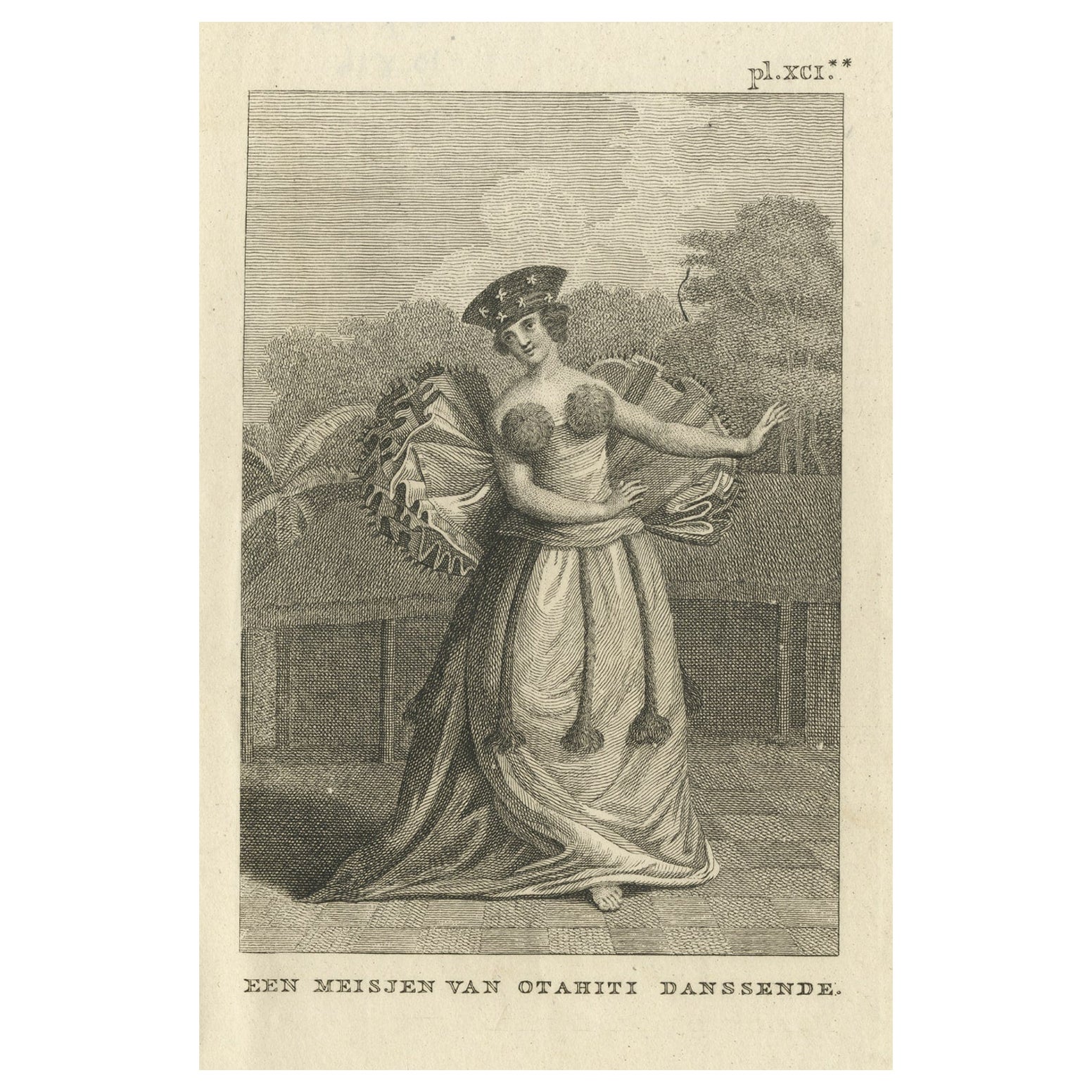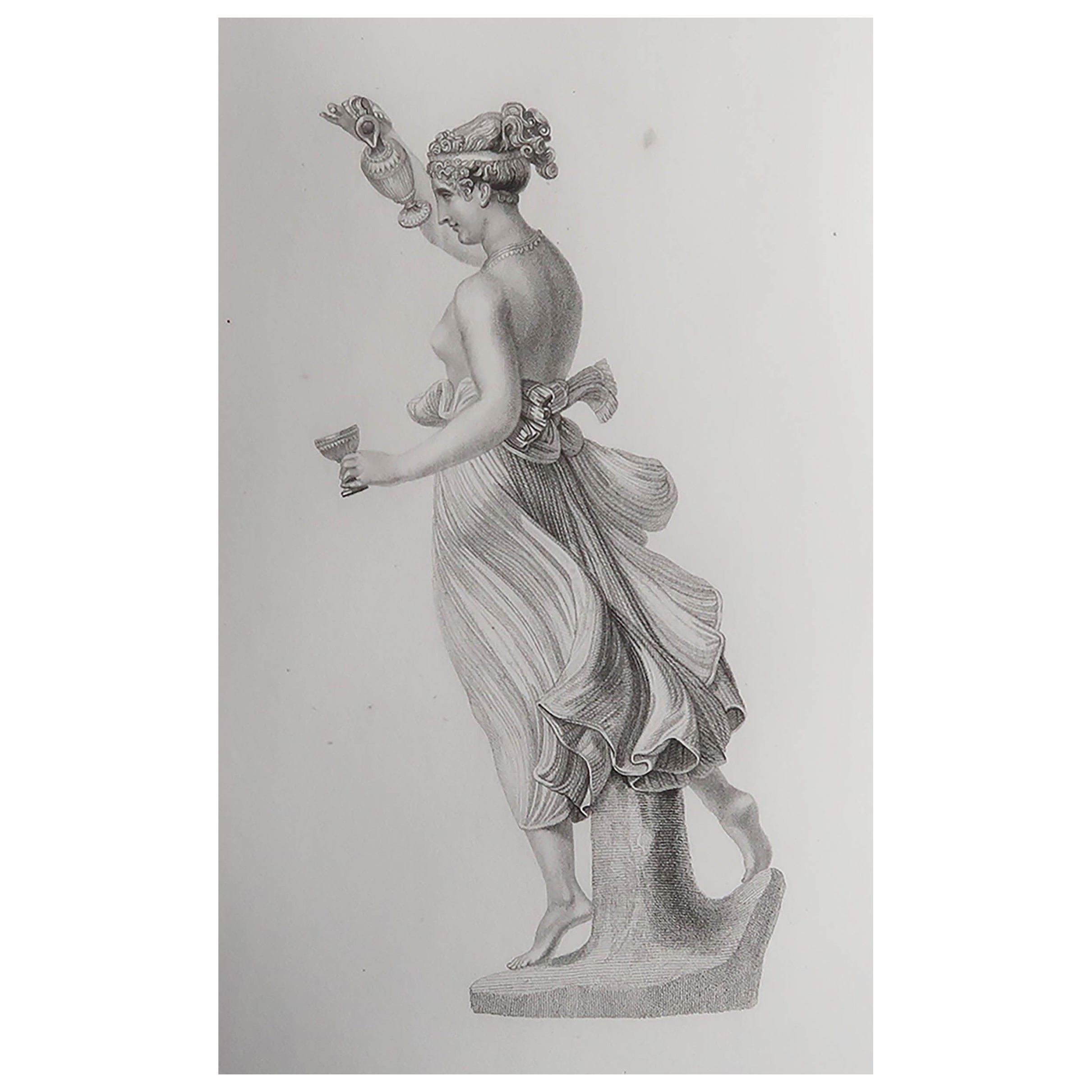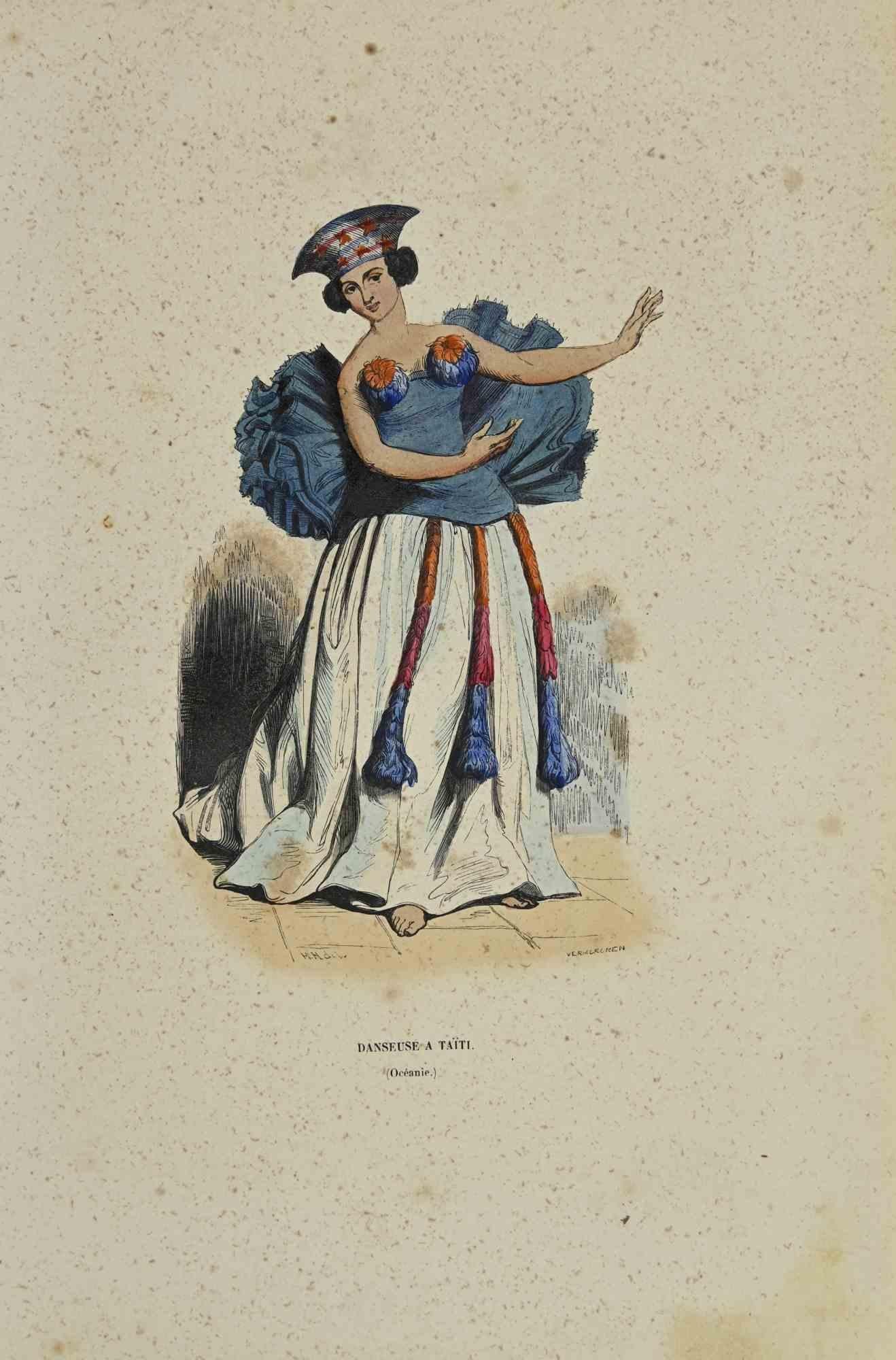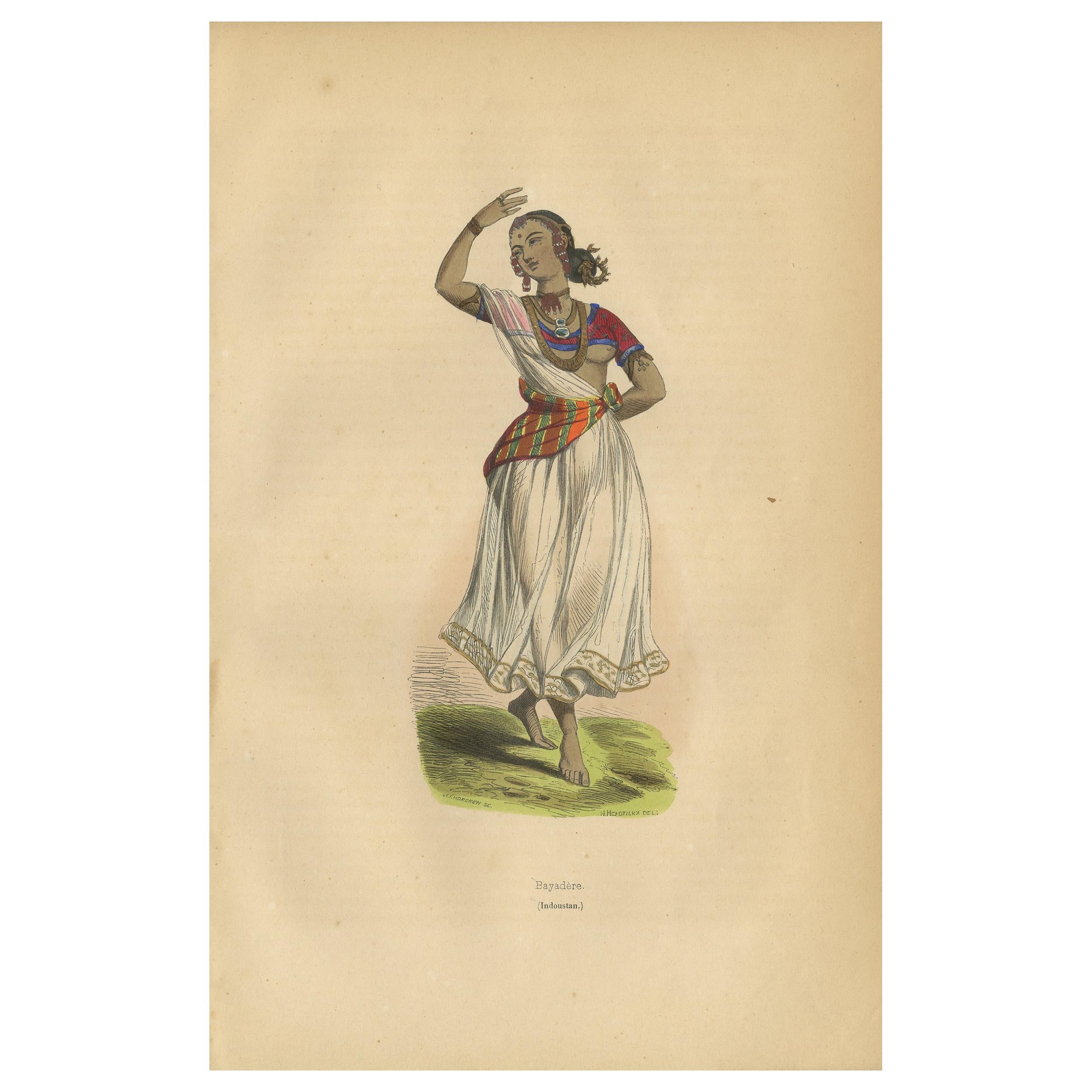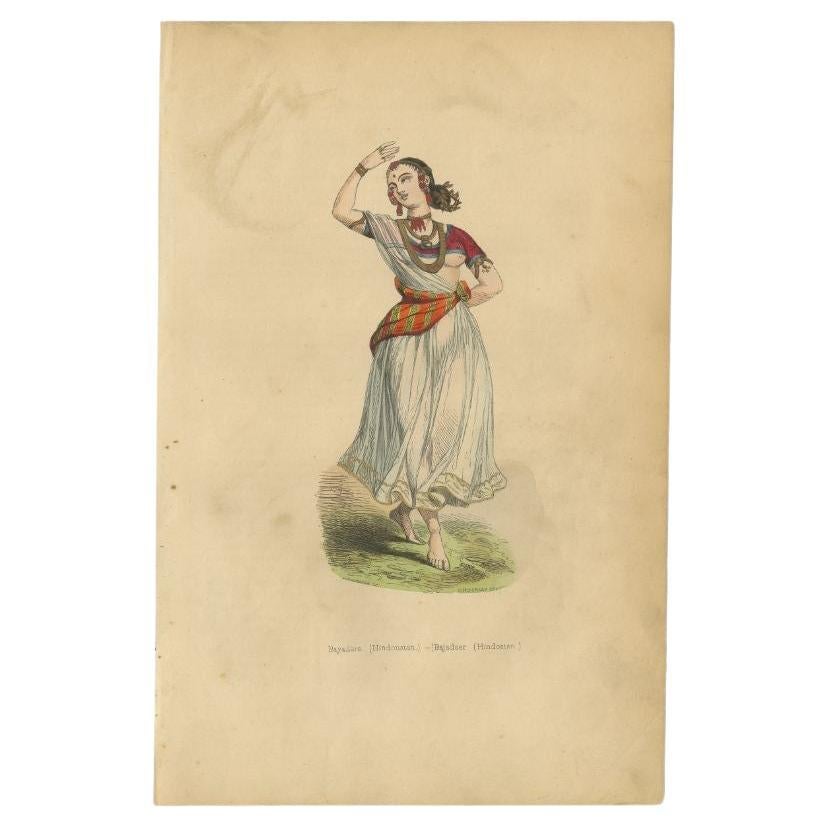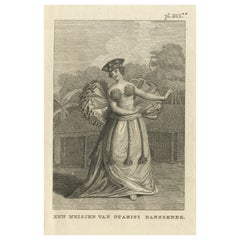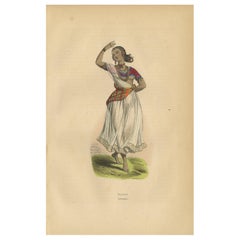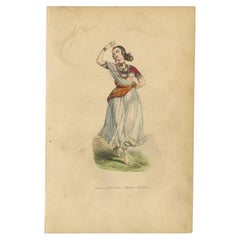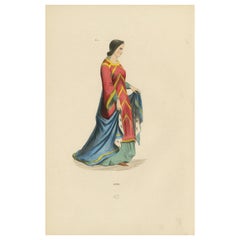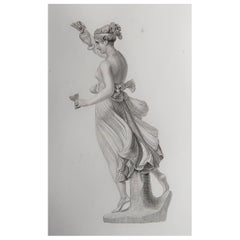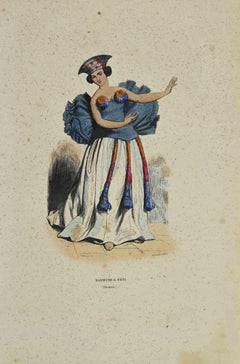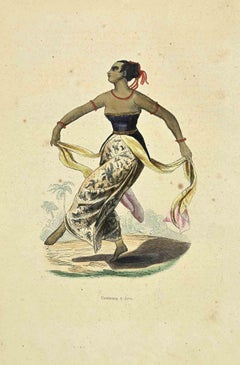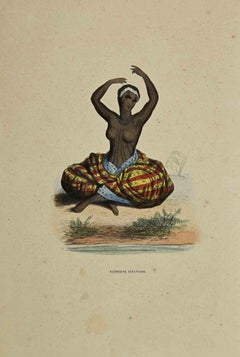Items Similar to Tahitian Grace: 1836 Engraving of a Dancer by Karl Joseph Brodtmann
Want more images or videos?
Request additional images or videos from the seller
1 of 7
Tahitian Grace: 1836 Engraving of a Dancer by Karl Joseph Brodtmann
$419.90
$524.8820% Off
£310.44
£388.0520% Off
€352
€44020% Off
CA$577.57
CA$721.9720% Off
A$642.01
A$802.5120% Off
CHF 336.53
CHF 420.6620% Off
MX$7,840.47
MX$9,800.5920% Off
NOK 4,201.34
NOK 5,251.6820% Off
SEK 3,952.68
SEK 4,940.8520% Off
DKK 2,679.77
DKK 3,349.7120% Off
About the Item
This lithograph by Karl Joseph Brodtmann presents a detailed portrait of a Tahitian dancer. The artwork is part of Brodtmann’s ethnographic series, capturing the attire, posture, and cultural significance of traditional dances in Tahiti, part of French Polynesia. The illustration reflects 19th-century European interest in the "exotic" practices and customs of non-Western cultures.
Description:
The lithograph depicts a Tahitian dancer in full traditional dress, posed gracefully as if in the midst of a dance. The dancer’s expression is serene, and her pose is elegant, with one hand extended outward and the other resting on her hip. Her costume and adornments are richly detailed, reflecting the vibrant cultural traditions of Tahiti.
- Attire: The dancer wears an elaborate skirt made from layers of fabric, possibly resembling the traditional pareu or tapa cloth, draped and flowing down to her feet. Around her waist is a sash, adding a layer of detail to her ensemble. Her upper body is adorned with what appear to be decorative pompons over her chest, and she wears a wide, decorative backpiece, which adds a sense of grandeur to her costume. The backpiece appears to be made from traditional materials like woven fibers or feathers, symbolizing her role as a performer in an important cultural event.
- Headwear: The dancer wears a headdress with intricate patterns and designs, possibly made from woven fabric or adorned with flowers, which was a common practice in Tahitian ceremonial dress. The headdress adds to her regal appearance and highlights the cultural significance of head adornments in Polynesian rituals and performances.
- Pose: Her pose is dynamic yet graceful, capturing the fluidity of movement that is characteristic of Tahitian dance. Tahitian dance, known as ’ōte’a, involves elaborate arm and hand movements, as well as rapid hip movements, and this pose suggests that she is performing one of these traditional dances. Her bare feet are visible, as dancing barefoot is customary in many Polynesian dances.
The lithograph emphasizes both the elegance of the dancer and the cultural importance of dance in Tahitian society, offering European audiences a glimpse into the ceremonial practices of Polynesia.
Maker:
Karl Joseph Brodtmann (1787–1862) was a Swiss lithographer renowned for his detailed illustrations of ethnographic and natural history subjects. His works, widely circulated in Europe during the 19th century, provided visual documentation of various non-Western cultures encountered through exploration and colonialism. Brodtmann’s ethnographic studies, such as this one, were intended to educate European audiences about distant lands and their peoples.
Technique and Style:
The lithograph was created using lithography, a technique that allowed Brodtmann to achieve fine detail and texture in the clothing and adornments of the dancer. His realistic style in this work captures the textures of the flowing fabric, the intricate patterns of the headdress, and the graceful posture of the dancer. Brodtmann’s careful shading emphasizes the three-dimensionality of the figure, giving life to the dancer’s movement and attire.
The overall composition is balanced and harmonious, with the dancer standing on what appears to be a simple wooden platform or stage, further highlighting the figure and her costume without any distractions in the background.
Cultural Context:
Tahitian dance has been a central part of Polynesian culture for centuries, used in religious ceremonies, celebrations, and storytelling. The dancer depicted here likely represents the role of women in these traditional performances, where they would wear elaborate costumes and perform dances that told stories of their gods, ancestors, and nature. Dance in Tahiti was not only a form of entertainment but also a sacred ritual, often performed during important cultural events.
The costume worn by the dancer, with its layered fabrics and intricate headpiece, reflects the artistic craftsmanship of Tahitian society, where costumes were carefully crafted from materials like tapa cloth, feathers, and natural fibers. These elements not only added beauty to the performance but also held symbolic meaning, often associated with fertility, status, or spirituality.
Brodtmann’s depiction of this Tahitian dancer provides European viewers with an image of the elegance and complexity of Polynesian cultural practices, during a time when the West was increasingly fascinated by the "exotic" and distant lands of the Pacific. This portrait contributes to the broader ethnographic documentation of Polynesia, illustrating the importance of dance and ceremony in Tahitian society.
- Dimensions:Height: 12.8 in (32.5 cm)Width: 10.24 in (26 cm)Depth: 0 in (0.02 mm)
- Materials and Techniques:
- Period:
- Date of Manufacture:1836
- Condition:Condition: good, given age. General age-related toning and/or occasional minor defects from handling. Some stains along the right border, not affecting the image. Please study scan carefully.
- Seller Location:Langweer, NL
- Reference Number:Seller: BG-13176-181stDibs: LU3054341516182
About the Seller
5.0
Recognized Seller
These prestigious sellers are industry leaders and represent the highest echelon for item quality and design.
Platinum Seller
Premium sellers with a 4.7+ rating and 24-hour response times
Established in 2009
1stDibs seller since 2017
2,604 sales on 1stDibs
Typical response time: <1 hour
- ShippingRetrieving quote...Shipping from: Langweer, Netherlands
- Return Policy
Authenticity Guarantee
In the unlikely event there’s an issue with an item’s authenticity, contact us within 1 year for a full refund. DetailsMoney-Back Guarantee
If your item is not as described, is damaged in transit, or does not arrive, contact us within 7 days for a full refund. Details24-Hour Cancellation
You have a 24-hour grace period in which to reconsider your purchase, with no questions asked.Vetted Professional Sellers
Our world-class sellers must adhere to strict standards for service and quality, maintaining the integrity of our listings.Price-Match Guarantee
If you find that a seller listed the same item for a lower price elsewhere, we’ll match it.Trusted Global Delivery
Our best-in-class carrier network provides specialized shipping options worldwide, including custom delivery.More From This Seller
View AllAntique Print of Dancing Girl of Otahiti or Tahiti by Cook, 1803
By James Cook
Located in Langweer, NL
Antique print titled 'Een Meisjen van Otahiti danssende'. Antique print depiciting a female native of Tahiti, dancing. Originates from 'Reizen Rondom de Waereld door James Cook (..)'...
Category
Antique 19th Century Prints
Materials
Paper
$229 Sale Price
20% Off
Antique Print of a Bayadère by Wahlen '1843'
Located in Langweer, NL
Antique costume print titled 'Bayadère (Indoustan)'. Original antique print of a bayadère (Hindu dancing girl). This print originates from 'Moeurs, usages...
Category
Antique Mid-19th Century French Prints
Materials
Paper
$95 Sale Price
20% Off
Antique Print of a Bayadèrea or Bayadère, a Hindu Dancer
Located in Langweer, NL
Antique costume print titled 'Bayadere (Hindoustan)'. Original antique print of a bayadère, Hindu dancer. This print originates from 'Moeurs, usages et costumes de tous les peuples d...
Category
Antique 19th Century Prints
Materials
Paper
$143 Sale Price
20% Off
Renaissance Grace: A Lady's Attire in 'Costume du Moyen Âge', 1847
Located in Langweer, NL
Title: "Renaissance Grace: A Lady's Attire in 'Costume du Moyen Âge'"
Description: This lithograph from "Costume du Moyen Âge," dated 1847, captures the elegance and vibrancy of a l...
Category
Antique 1840s Prints
Materials
Paper
$143 Sale Price
20% Off
Antique Costume Print of a Young Mulatta by Wahlen, 1843
Located in Langweer, NL
Antique costume print titled 'Jeune Dame Mulatre'. Original antique print of a young Mulatta. This print originates from 'Moeurs, usages et costumes de tous les peuples du monde' by ...
Category
Antique Mid-19th Century Prints
Materials
Paper
$95 Sale Price
20% Off
Ceremonial Grace: The Gift-Bearing Attire of a Tahitian Woman in 1799
Located in Langweer, NL
Engraved plate by John Webber, titled "A Young Woman of Otaheite, in the dress they assume when bringing a Present."
This work was included in the published account of Captain Jame...
Category
Antique Late 18th Century English Prints
Materials
Paper
$334 Sale Price
20% Off
You May Also Like
Original Antique Print of The Greek Goddess, Hebe. Dated 1833
Located in St Annes, Lancashire
Wonderful image of Hebe
Fine steel engraving.
Published by Fisher. Dated 1833
Unframed.
Category
Antique 1830s English Neoclassical Prints
Materials
Paper
Danseuse a Taiti - Lithograph by Auguste Wahlen - 1844
Located in Roma, IT
Danseuse a Taiti is a hand colored lithographs realized by Auguste Wahlen in 1844.
Good conditions.
The artwork belongsto the Suite Moeurs, usages et costumes de tous les peuples d...
Category
1840s Modern Figurative Prints
Materials
Lithograph
Danseuse a Java - Lithograph by Auguste Wahlen - 1844
Located in Roma, IT
Danseuse a Java is a hand colored lithographs realized by Auguste Wahlen in 1844.
Good condition.
The artwork belongs to the Suite Moeurs, usages et costumes de tous les peuples du...
Category
1840s Modern Figurative Prints
Materials
Lithograph
Danseuse Javanaise - Lithograph by Auguste Wahlen - 1844
Located in Roma, IT
Danseuse Javanaise is a hand colored lithographs realized by Auguste Wahlen in 1844.
Good condition.
The artwork belongs to the Suite Moeurs, usages et costumes de tous les peuples...
Category
1840s Modern Figurative Prints
Materials
Lithograph
A Young Woman of Otaheite, Dancing (Tahiti) 1784 Captain Cooks Voyage by Webber
By John Webber
Located in Paonia, CO
A Young Woman of Taheite Dancing (Tahiti) is from the 1784 First Edition Atlas Accompanying Capt. James Cook and King; Third and Final Voyage of Captain James Cook.John Webber (1752-...
Category
1780s Realist Figurative Prints
Materials
Engraving
19th Century Lithograph, a Portrait of a Dancer
Located in Opole, PL
We present you this black and white lithograph depicting Caroline Vilhelmine Fjelsted (1821-1881), a Danish theatrical dancer.
The author is Elias John Cardon.
The graphic was ...
Category
Antique 1840s Danish Prints
Materials
Paper
$1,336 Sale Price
20% Off
More Ways To Browse
Western Skirt
Fertility Wooden Figure
Tapa Cloth
Dovetail Vinyl Record
Dragon Boat
Egyptian Cat
Embossed Copper Box
English Bow Front Chest
English Headboard
English Iron Bed
Folding Travel Clock
Fornasetti Paper
Four Poster Bed Kings
Francois Pompon
Franz Xavier Bergman
Frem Rojle Chair
French Confit Jar
French Opaline Bottle
